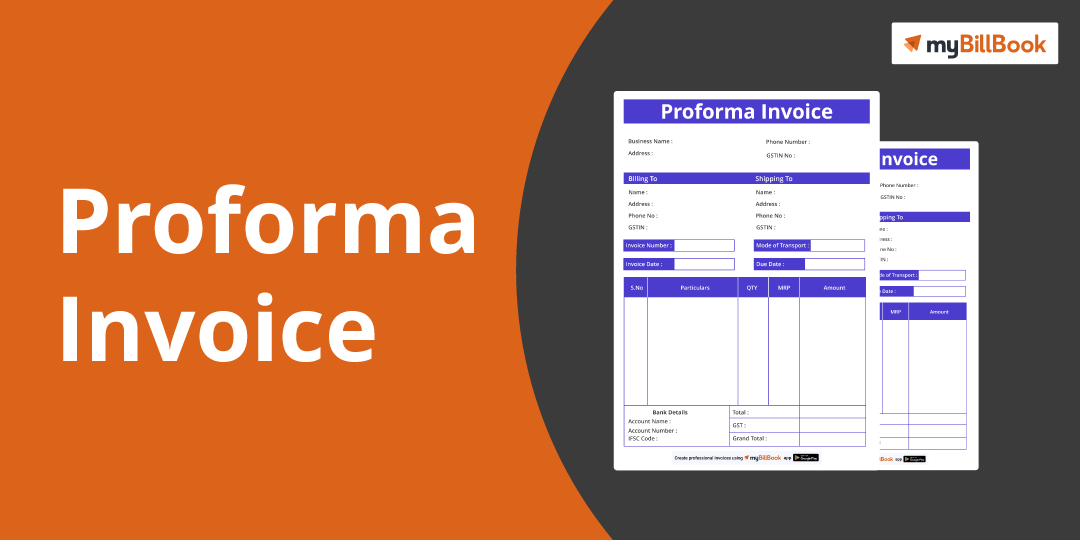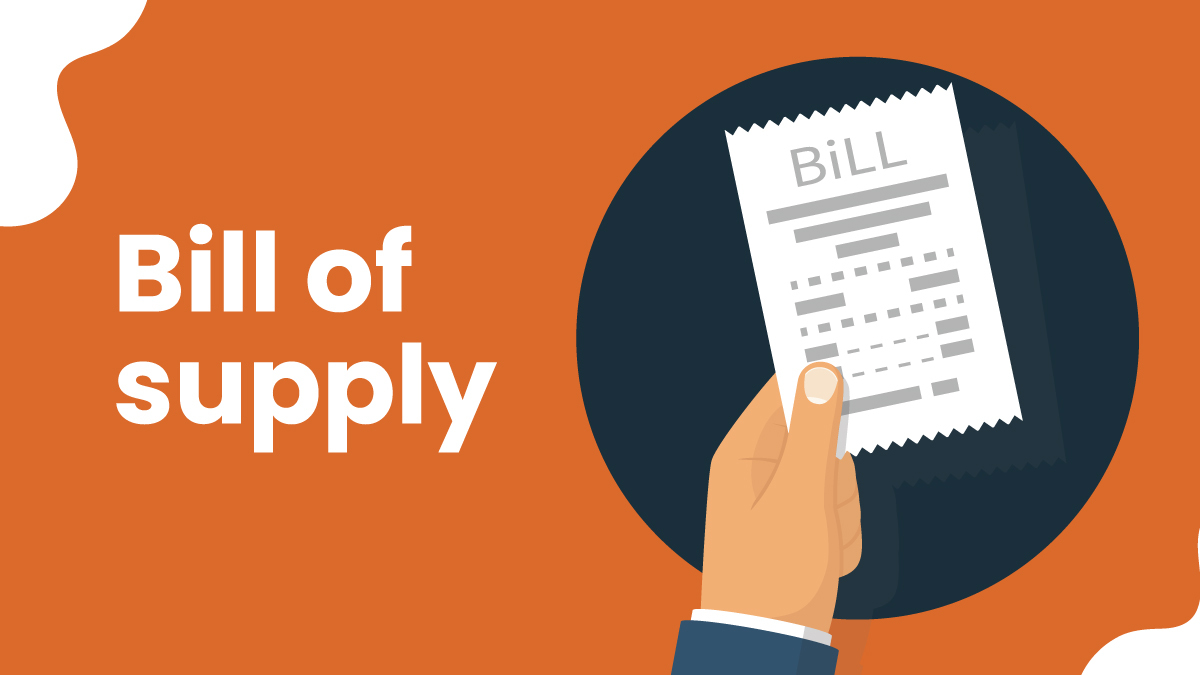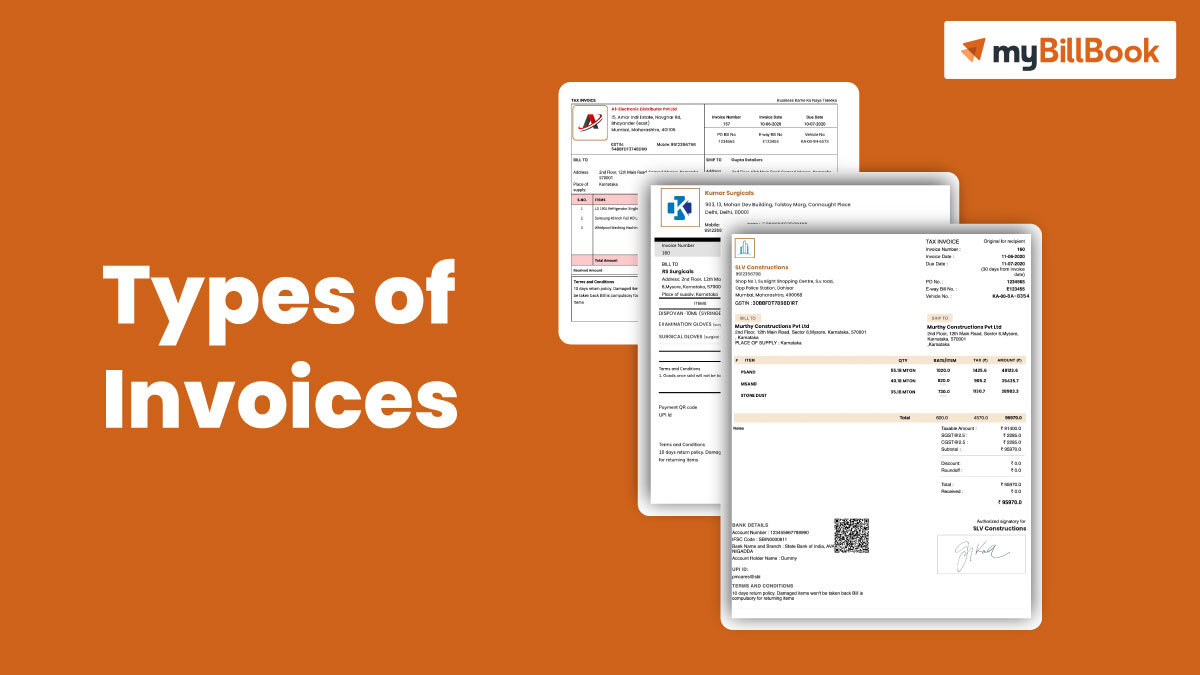What is Invoicing | A Guide for Small & Medium Businesses in 2024
An invoice is an important document that records a sale or supply of goods from a seller to a buyer. The GST (Goods and Services Tax) law in India has set some rules and guidelines for creating a tax invoice, using an invoice, and sharing an invoice. This page will make you aware of the key elements of invoicing and billing.
Whether you’re an aspiring businessman, an entrepreneur, or an established business owner, having the right knowledge about billing and invoicing is crucial.
If you are thorough with the fundamental aspects of invoicing, you can ensure that your business is following the right billing practices, compliant with regulatory requirements, and generating accurate and efficient invoices.
This page with the invoicing guide will help you understand the basics of invoicing, types of invoices, invoice format, legal requirements, invoice management, common challenges in invoicing, upgrading to automation, future trends, and much more.
Understanding Invoicing – Invoice | Bill | Invoice Vs. Bill
Let’s start with the basics of invoicing. This section will cover –
- What is Invoice?
- Purpose of an invoice
- What is a Bill?
- Difference between Bill and Invoice
What is an Invoice | Invoice Definition
An invoice is a commercial document that records a transaction between a seller and a buyer. Typically generated by a seller, an invoice lists all the items sold or the services provided, along with their quantity, price, tax, total amount, due date, and other payment terms.
An invoice can be a paper bill from a supermarket or an online invoice from an e-commerce retailer like Amazon or Flipkart.
Purpose of an invoice
Why do we need to generate an invoice or a bill? Can’t we sell goods or services without an invoice? Well, here is the answer defining the purpose of generating an invoice.
- Legal Proof
A bill or an invoice is legally required as proof of sale. It specifies what, when, to whom, and in what quantity the item was sold. All the registered businesses are required to produce a bill for all sales transactions.
- Request for Payment
An invoice serves as a formal and legal document to request payment from a customer for the goods/services sold.
- Record Keeping
Generating a bill for every transaction helps businesses keep track of all the sales. A record of all the transactions helps calculate the revenue and manage inventory.
- GST-Compliance
All the registered businesses are required to generate GST invoices for sale of all goods or services. The GST invoices are essential for GST reporting and tax filings.
- Cash Flow Management
For sales made on credit, invoices set clear payment terms and deadlines. This helps businesses receive timely payments, manage cash flow, and maintain financial stability.
- Dispute Resolution
In case there are any disputes related to payment or any other terms related to billing, the invoice acts as an official reference, providing clarity.
What is a Bill? | Bill Definition
A bill is a document that also acts as proof of sale. Just like an invoice, it also lists the transaction details of a sale or a service. A bill is generated by the seller of goods or provider of services to the customer. A bill can be a printed receipt or an online soft copy.
Difference Between Bill and Invoice
The terms bill and invoice are used interchangeably. Even though their primary purpose is to record a transaction, there are slight differences based on their usage, context, and payment terms. Listed below are key differences between invoices and bills.
| Bill | Invoice | |
| Purpose | Immediate Payment – Where instant payment is required | Delayed Payment – When payment is expected at a later date |
| Context |
|
|
| Example | A receipt from a restaurant, a printed slip from a grocery store | Invoice raised by a freelancer for the services provided, manufacturer’s invoice to a retailer for a bulk order |
| Usage | Serves as a receipt once payment is made | Acts as a formal request for payment |
| Content | Simple Format | Detailed Information |
| Details | Transaction Details | Transaction details, payment terms & conditions, penalties for late payments |
| Accounting Books | Confirms the receipt of full payment | Forms part of a business’s accounts receivable |
Types of Invoices
Now that you understand the definition of an invoice and how it is different from a bill, let’s examine the different types of invoices.
- Sales Invoice
- Proforma Invoice
- Credit Notes
- Debit Notes
- Commercial Invoice
- Purchase Order Invoice
- Recurring Invoice
- Timesheet Invoice
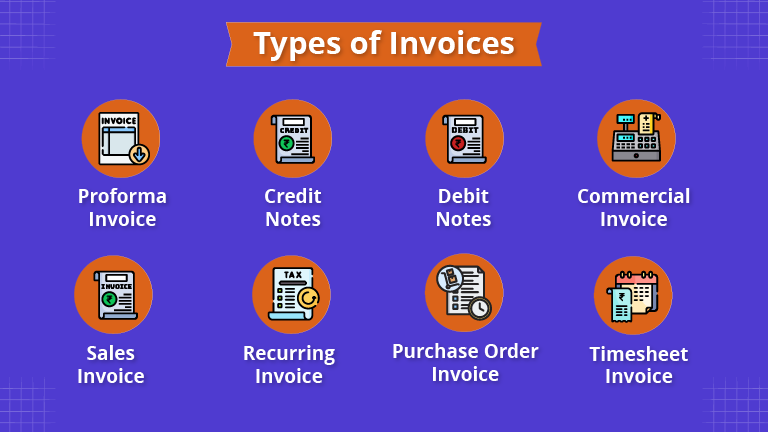
Sales Invoice
Sales Invoice is a legally binding document that records a transaction between seller and buyer and requests payment for the goods sold or services rendered.
Proforma Invoice
A proforma invoice is a preliminary invoice that is issued before generating an actual invoice. A proforma invoice is not a legal document.
Credit Notes
A credit note is issued by the seller when there is return of products by the buyer.
Debit Notes
A debit note is issued by a buyer requesting return of funds in case of a purchase return.
Commercial Invoice
Used in international trade, a commercial invoice is a legal document that records the export transaction between a buyer and a seller.
Purchase Order Invoice
A purchase order is a document created by the buyer outlining their requirements and expectations about the product and the quantity they are planning to purchase.
Recurring Invoice
Recurring invoice is a regular sales invoice that is sent to buyers or customers on a recurring schedule. The details of the transaction like the products, quantity, customer details remain same.
Timesheet Invoice
Used in the service industry, a timesheet invoice helps companies to charge clients for a particular task or a project on an hourly basis.
Types of Invoices Under GST
Under Goods & Services Tax, there is a new set of invoices, including some from the regular invoices. The types of invoices under GST include –
- Tax Invoice or GST Invoice
- Bill of Supply
- Delivery Challan
- Credit Note
- Debit Note
- e-Invoice
- e-Way Bill
- Receipt Voucher
- Refund Voucher
- Payment Voucher
- Supplementary Invoice
GST Invoice or Tax Invoice
As per Section 31 of the CGST Act, a registered seller supplying taxable goods must generate a tax invoice. A tax invoice is a detailed record of a transaction between a seller and a buyer. Besides the regular invoice details, a tax invoice must include the respective tax rates like GST, CGST, IGST, etc.
A tax invoice for the sale of goods must be generated before or at the time of delivery. However, for supplying services, GST invoices can be issued before, at, or even after the time of supply.
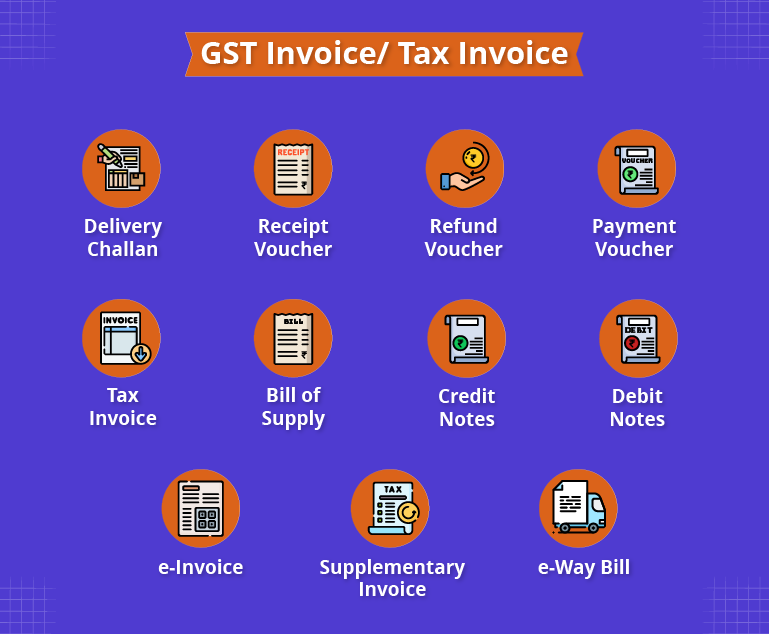
Bill of Supply
A registered seller supplying exempted goods or services or both or paying tax under a composition scheme should issue a bill of supply instead of a tax invoice.
Delivery Challan
A delivery challan is issued when goods are transported from one place to another but not necessarily because of a sale.
Receipt Voucher
A registered seller issues a receipt voucher upon receiving an advance payment for any supply of goods or services.
Refund Voucher
A refund voucher is generated when a seller fails to supply the goods after generating a receipt voucher. Which means after receiving an advance payment. In such cases the seller issues a refund voucher against the received advance.
Payment Voucher
A registered seller paying taxes under reverse charge shall issue a payment voucher while making a payment to a supplier.
Supplementary Invoice
A supplementary invoice can be used to revise an invoice due to an upward change in the product or service price. It must be issued within 30 days of the price revision by the goods or services provider.
e-Invoice
e-Invoice is a digitally signed and verified document used for B2B transactions. It contains all the details, like that of a sales invoice, but is validated by the government tax portal.
e-Way Bill
According to Rule 138 of CGST Rules, an e-way bill is mandatory for the movement of goods valued above a specified limit within India. The movement of goods could be for supply or reasons other than supply.
Format & Contents of an Invoice
In this page we will predominantly talk about the regular invoice, also called as sales invoice. This section explains about invoice format, GST invoice format and contents of a sales invoice.
Standard Invoice Format
Standard invoices should have a common format for all the transactions as per the industry standards. Following a consistent format makes it easy for businesses to generate invoices and also create a brand image. An invoice must contain all the information a customer requires to make payments and should also provide an opportunity to address any questions.
Elements of a Standard Invoice
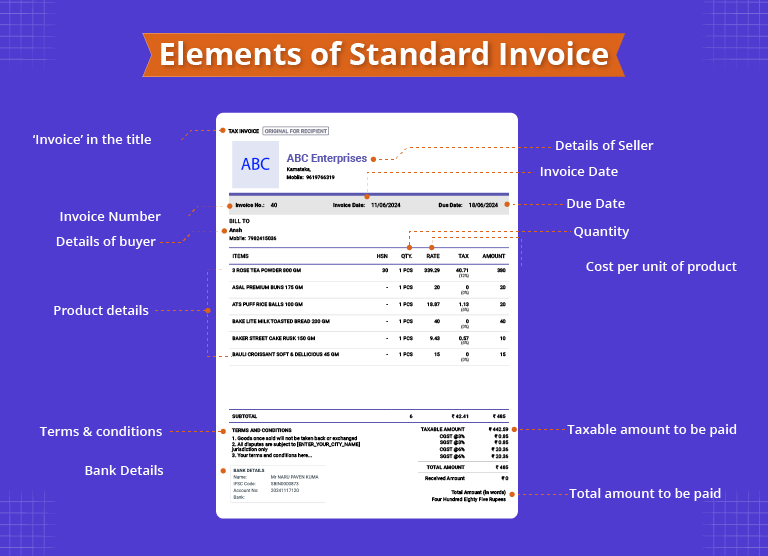
A standard invoice must contain the following elements –
- ‘Invoice’ in the title
- Invoice number
- Invoice Date
- Details of the seller
- Buyer details
- Product/Transaction details
- Cost per unit of product
- Quantity
- Price
- Tax rate
- Total amount to be paid
- Terms and conditions
- Due Date
- Payment Terms
GST Invoice Format
A tax invoice or a GST invoice must be issued by a registered person with the following details –

- Name and Address of the Supplier
- Goods and Services Tax Identification Number (GSTIN) of the supplier;
- A unique invoice number
- Date of issue
- Name of address of the recipient or the buyer, GSTIN (if registered)
- Delivery Address
- HSN Code
- Detailed description of goods or services
- Quantity or Unit
- Total value
- Taxable Value
- Rate of Tax (CGST, SGST, IGST, Union Territory or Cess)
- Amount of tax
- Place of supply
- Whether the tax is payable on a reverse charge basis
- Signature of the supplier
- Quick Response code with Invoice Reference Number (IRN) (in case of e-invoice)
How to Create an Invoice
An invoice can be created in different ways. Some of the most common ways to create invoices are listed below –
- Manual – Pen & Paper-based Invoices
- Online Invoice Templates
- Online Invoice Generator
- Word Processing Tools – Word, Excel, Docs
- Billing Software
If you’re testing formats, try our free invoicing software—create GST invoices in minutes without Excel templates.”
How to Create Invoices Manually
Manual invoices are handwritten paper bills. Despite the advancement of technology, some businesses still rely on pen-and-paper methods to create bills. This method might seem easy and convenient, but just entering the product names, prices, and the total amount on a blank paper does not make it a valid bill. It might act as a reference document for the customer to know the prices, but for accounting purposes, it is of no use. Hence, it is highly recommended not to create paper bills.
Creating Invoices Using Word, Excel, and Docs
Instead of using paper bills, you can use word processing software like Word, Excel, and Google Docs to create invoice templates of your choice. This method provides you with an option to tailor your invoices to your needs. You can create invoice formats in Word, invoice templates in Excel, invoice formats in PDF, and bill formats in Docs. Once you create a template using any of these tools, you can either fill the templates online or take a printout of them and fill them out manually.
Creating Invoices Using Invoice Templates
If you don’t want to take the hassle of creating invoice formats from scratch, you can use ready-to-use invoice templates available online. You can download such invoice templates, take a printout of the same and use them to create bills. However, even while using the templates, you need to enter the information manually using a pen and hand it over to your customers.
Creating Invoices Using Online Invoice Generators
To completely avoid pen and paper-based invoice creation, you can rely on free online invoice generators. These free tools help businesses to generate printed invoices. Choose a reliable online bill generator, pick a template that suits your needs, enter the required information in the bill, and print or download the invoice. Online-generated invoices look professional compared to hand-written invoices and paper bills.
Invoice Creation Using Billing Software
All the methods mentioned above have their own drawbacks. While manual bill generation is not possible in a hectic billing environment, relying on free resources with your business information is not a secure option. One solution that can effectively overcome all the challenges posed by all the invoice generation methods is to have billing software in place.
A billing software, preferably cloud-based, is a very handy tool for businesses to generate invoices without much trouble. With auto-populated data options, the software significantly minimises data entry and other billing errors. As in cloud software, the data is end-to-end encrypted and is securely stored in remote servers, you don’t have to worry about the safety and security of your business information.
The cloud-based setup also makes it an affordable billing solution for businesses of all sizes, especially small and medium enterprises.
Invoice Management
Creating an invoice is just the beginning of the invoice management process. Every business, along with creating accurate invoices, must ensure that –
- Invoices are delivered to the clients promptly
- Payment terms are communicated effectively
- Flexible payment options are provided
- Invoice status is being tracked
- Payment reminders are being sent
- Proper invoice record keeping is in place
- Dispute resolution is in place to handle any invoice-related discrepancies
- Reports are generated to analyse invoice data
- Key performance indicators are tracked to identify areas for improvement
Effective invoice management is crucial for maintaining healthy cash flow, enhancing customer satisfaction, and ensuring compliance with financial regulations.
Invoice Sharing With Clients – Different Methods in Use
Invoice sharing is part of invoice management. Choosing the right method/s to share invoices is crucial to ensure timely delivery and prompt payments. An effective invoice-sharing method not only improves the cash flow of a business but also helps in maintaining positive client relationships. Let’s now explore different ways to share invoices.
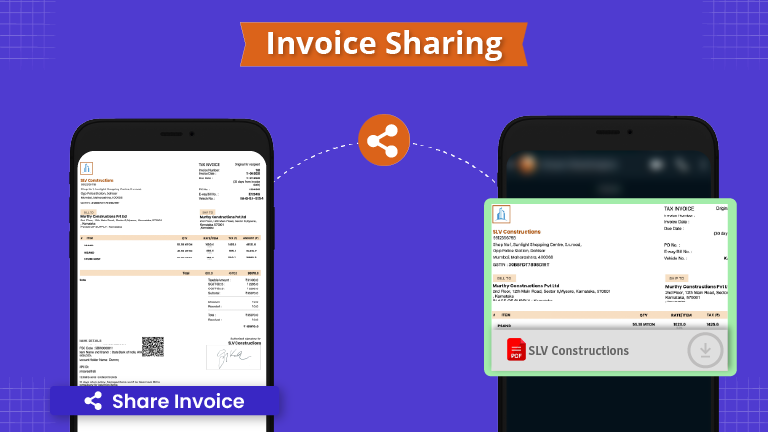
Physical Invoices
Physical invoices or hard copies of invoices are issued to clients who prefer to have physical documentation. This method prints invoices, and the hard copies are handed over to the clients. The handing over can be done directly, through post, or by courier.
e-Mailing Invoices
Electronically mailing an invoice is a commonly used method as it offers a secure platform to share invoice information. Once the invoice is created, it can be sent to the client’s e-mail address as an attachment. While sharing invoices through emails, attaching them in PDF format is recommended.
Using Secure File Sharing Services
You can also use file-sharing services like Dropbox, Google Drive, or OneDrive to share invoices securely. This method is more helpful when sharing larger files and to share multiple invoices simultaneously. Once the invoice is generated, you can upload it to any of the file-sharing apps, and get a shareable link with appropriate permissions (view or edit) and expiry dates. You can share this link with your customer or choose an option to send an email notification.
Through WhatsApp
One of the easiest ways to share invoices is through Whatsapp. It hardly takes any effort to share an invoice using this popular messaging channel. Once the invoice is generated, share it as an attachment to your client’s Whatsapp number directly. You can attach any kind of format, like Docs, Sheets, PDFs, etc., in WhatsApp.
Common Challenges with Manual Invoicing
Manual invoicing, or the process of using pen, paper and other manual methods to conduct billing, is quite familiar to most businesses. The method might seem convenient, especially at the beginning of the enterprise. However, except for billing, the other invoice management practices, as mentioned above, are hard to practice using manual billing. It also poses significant challenges, like the ones mentioned below, making it difficult to conduct billing. Let’s look at some of the common billing mistakes.
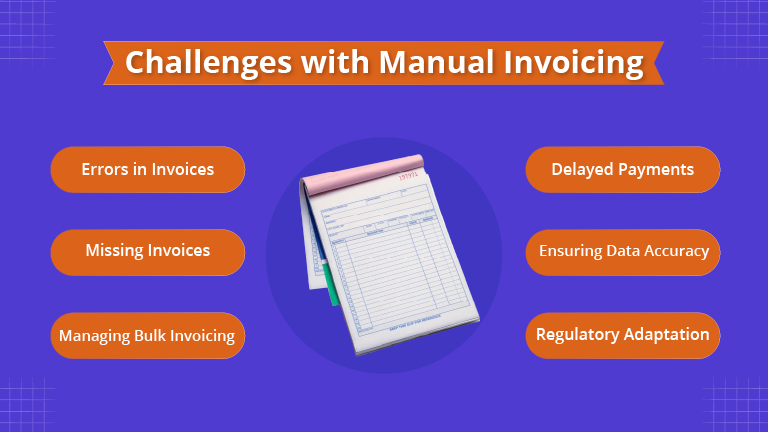
Errors in Invoices
Data entry errors and calculation mistakes are the most common errors in manual billing. Incorrect billing and wrong customer information often lead to disputes and payment delays.
Missing Invoices
In manual billing, there is no proper tracking system. Hence, the chances of misplacing and losing invoices are high. Missing invoices again leads to delayed payments and other tax-related complications.
Delayed Payments
Manually tracking the invoices and following up with the clients is inconsistent and time-consuming. This leads to delayed payments that could affect the cash flow.
Managing Bulk Invoicing
While managing single invoices is difficult, bulk invoicing is time-consuming and labour-intensive and can lead to delays. Further, the larger the number of invoices, the higher the chances of errors.
Ensuring Data Accuracy
Besides billing, manually keeping product/service details and customer information up to date is prone to errors and can result in inaccurate invoices. Further, the same data needs to be entered multiple times across different platforms, which increases the likelihood of errors.
Adapting to Regulatory Changes
Staying up to date with frequent changes in tax laws and regulations, such as GST updates, is a significant challenge. Manual systems require regular updates to ensure compliance, which can be labour-intensive and prone to mistakes.
Using Automation to Avoid Billing Errors & Streamline Your Billing Process

If you are still using manual billing or any other method that is inconsistent with the current regulatory requirements and the market standards, it’s high time you consider upgrading your billing system.
One of the best billing solutions that could resolve most of the billing challenges, especially those with manual billing, is to use an automated system like billing or invoicing software.
An efficient billing system significantly reduces billing errors, making billing faster and more accurate. It also helps you streamline your billing operations by providing prompt invoice delivery options, enabling efficient payment methods, invoice tracking, auto-reminders, dispute resolutions, report generation, etc.
What is Billing and Invoicing Software?
Billing software or invoicing software is a program designed to streamline most of an organisation’s billing processes. From invoice creation, delivery, tracking, and sending payment reminders to payment collection, billing software takes care of most billing operations without much manual intervention.
Broadly, there are two types of billing software.
- On-Premise Billing Software
- Cloud-based Billing Software
On-Premise Billing Software
On-premise billing software is like any other software you install on your PC. It is installed and runs on the local servers or computers within an organisation. For an on-premise billing software, you need to purchase licenses and possibly additional hardware to support it.
Pros & Cons of On-Premise Billing Software
| Advantages | Disadvantages |
| Full control and customisation to meet specific business needs | Software licences and initial hardware are a bit expensive |
| Data is stored on local servers, hence is more private and secured | Continuous IT support is required for maintenance, updates and troubleshooting |
| Recommended for larger enterprises with dedicated IT resources | Scaling up would be expensive as it requires additional hardware |
Cloud-Based Billing Software
Cloud-based billing software, also known as Software as a Service (SaaS), is hosted on remote servers and is accessed via the Internet. Instead of purchasing the software, you can subscribe to cloud-based billing software and pay a recurring monthly or annual subscription fee.
Pros & Cons of Cloud-Based Billing Software
| Advantages | Disadvantages |
| Can be customisation to meet specific business needs | Requires stable internet connectivity to access all features |
| Data is stored on remote servers and, hence can be accessed from anywhere with an internet connection | Data is stored on external servers hence, it requires choosing reliable and reputable providers that offer robust security measures. |
| Recommended for larger enterprises with dedicated IT resources | |
| No initial costs or maintenance costs. No hardware is required. | |
| Highly scalable to accommodate business growth | |
| Ideal for small & medium businesses, companies with remote teams, and start-ups |
How to Choose the Right Billing Software
Whether you are a small business owner, a freelancer, or a large enterprise, choosing the right billing software is a critical decision that can significantly impact your business’s financial success. With many options available in the market, it can be overwhelming to find the perfect fit for your specific needs. Here are 7 tips that can help you choose the best billing or invoicing software.
- Evaluate Your Billing Needs – Let Your Business Choose the Software
- Prefer Scalability – A Growing Business Requires Scalable Resources
- User-Friendly Interface is a Must – Empower Your Workforce
- Allows Customisation – Personalised Invoices Make a Difference
- Automation Makes Your Life Easy – Automatic Payment Reminders, Recurring Invoice Generation
- Security and Compliance – Data Encryption and User Authentication
- Easy to Access Customer Support Team and Timely Software Updates




